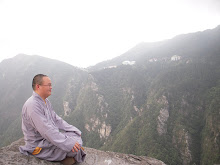
Three Sūtras in Mahāyāna Buddhism
When Mahāyāna Buddhism was transmitted through East Asia into China, its concrete values were accompanied by an extremely thorough, careful, and insightful translated project composed by sufficient oeuvre. Based on the fundamental components of the Buddha’s teaching which can be located within the discourse of three basic models: (1)The four dogmas, or noble truths; (2)the twelve links of dependent origination; and (3)impermanent, Mahāyāna Buddhism in East Asia, without doubt, cultivated on its own concepts, which are substantial and dramatic, entitled “Buddha-nature, Middle-way, Emptiness, and Pure Land ” which could be referred to Saddharmapundarīka-Sūtra, Vajra-cchedikā-prājñāpāramitā-sūtra, and Amitāyus- Sūtra.
1) Saddharmapundarīka-Sūtra was translated into Chinese by Kumārajīva during the fourth century C.E. According to the Mahāyāna’s principle, the most important and wonderful truth as found in this Sūtra is said to contain Buddha’s complete truth as compared with his previous, partial, or expedient teaching. Like Buddha himself said: “I have been a teacher to guide you on the path of the Dharma for such a long time, now it is the time to tell you the truth.” In this Stūra Buddha mentioned that everyone is able to become a Buddha, even though he or she never practices the Dharma: “Good men and believing women, all of you are going to become a Buddha if you invoke the refuge to the Buddha.” It has profoundly influenced Buddhist doctrine in East Asia, i.e., China, Korea, and Japan. In China, for example, the special classic of the Tiantai sect was established on it by the great Master Zhiyi.
2) Vajra-cchedikā-prājñāpāramitā-sūtra, also known as the Diamond Sūtra, is one of the most important Sūtras of the Mahayana Buddhism in the East Asia. It interprets the wisdom of empty. “Vajra” means the element of the universe. It is the strongest and finest, and it will never be destroyed by any kind of powers, for “empty” cannot be destroyed. The Diamond Sūtra also evolves the six parāmitas of the Bodhisattva path with its emptiness doctrine. During the fourth century C.E., it was introduced into China by Kumārajīva. And it became popular after the great Chan Master Hui-neng, the sixth patriarch of the Chinese Chan Buddhism.
3) Amitāyus- Sūtra was translated into Chinese by Sanghāvarman in 252.C.E. It is the first translation of the Pure Land texts in China. With its special doctrine which describers the Amitābha’s forty-eight vows, it has been enforced in China, Korea and Japan after the Song Dynasty (960.C.E.-1279.C.E.) According to the Amitāyus Sūtra, if those who believe in Amitābha’s vows, have a mind to be born in the Pure Land, and invoke Amitābha, they are accepted. It ensures that you do not need a lot of practices of Dharma to achieve the way to Bodhisattva. All you have to do is to invoke Amitābha in order to be born in the Pure Land of Amitābha after you die.
In terms of the perspective of the Mahāyāna Buddhism’s teaching, that being said, the three stūras in Mahāyāna Buddhism are particular in the evolution of the notions of Buddha-nature, Middle-way, Emptiness, and Pure Land in the East Asian scriptural tradition.
ZhenGuan

No comments:
Post a Comment